Billions for Sustainability? Threats and opportunities of EU funds in Central and Eastern Europe
Big money is en route to Central and Eastern Europe...
The European Union currently invests around €8 billion a year in its new member states through Structural and Cohesion Funds. The subsidies can be used for all kinds of projects: transport infrastructure, sewage treatment plants, support for businesses, training and education. From 2007 on and including Bulgaria and Romania, this flow of euros will increase to 22.5 billion a year. In per capita terms, this is significantly more than the Marshall Plan after the Second World War. Several more billions are to be added as co-financing from the budgets of the recipient countries.
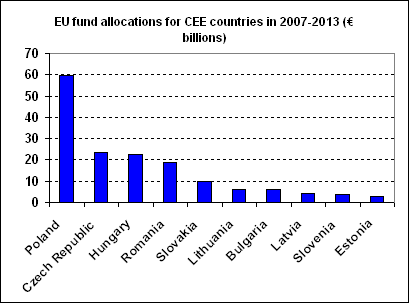
...but how will it be used?
This huge financial injection, guided by the EU’s cohesion policy, will shape the long-term development of the regions east of the former Iron Curtain. As to what kind of development the EU billions will support, this depends on how exactly the funds are used:
- for more large-scale motorway projects or for improving public transport?
- for expensive and polluting waste incinerators or for waste prevention and recycling?
- for channelling rivers with concrete or for integrated river basin management?
- for environmental destruction or for nature conservation?
- for energy-intensive projects or for energy savings?
Effective and environmentally benign use of EU funds is very much in the interests of people in the new member states as well as of taxpayers all over Europe.
Threats to the sound use of the funds are numerous...
Currently, the EU often finances environmentally harmful or economically doubtful projects. It also supports unsustainable, outdated types of development, for example in the transport and waste sectors. While the EU publicly promotes reducing the growth of freight transport and shifting it from road to rail, the majority of its funds for transport go to financing roads, which contribute to ever increasing car and truck traffic. And while the EU openly promotes the prevention and recycling of waste over incineration and landfilling, most of its subsidies are likely to be spent on the latter two waste disposal methods.
...but so are the opportunities.
However, EU funds have the potential to foster sustainable development, as long as the rules and priorities are set right both in Brussels and in national and regional capitals. The plans for the use of the funds in the period 2007-2013 are currently being prepared. This is a unique chance for the CEE countries to set their economies on a sustainable path, bringing real improvements to people’s quality of life.
Transport: avoiding the vicious circle

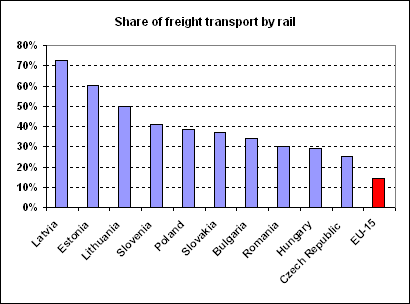
The new member states can still avoid the vicious circle – familiar across western Europe – of ever increasing car dependency, noise and air pollution, urban sprawl, chronic congestion, and further road building. The share of freight transported by rail and of passengers transported by public transport in the new member states is still considerably higher than in the old member states (see charts), although it has declined in favour of trucks and cars in recent years. Money has been poured into building new motorways (usually part of the EU-promoted Trans-European Networks) that serve lorries, while motorway fees cover only a minimal part of their costs. At the same time the railways have suffered from a lack of financing and increasingly expensive charges for their usage.
EU funds should be used to reverse these trends in order to make the best of the new member states' advantage in rail and public transport. Unfortunately, money from both Structural and Cohesion Funds has so far been skewed in favour of motorways and roads in the new as well as in the old EU member states. In the latter, 50% of transport investments from Structural Funds went to roads and motorways and only 29% to the railways between 2000 and 2006.
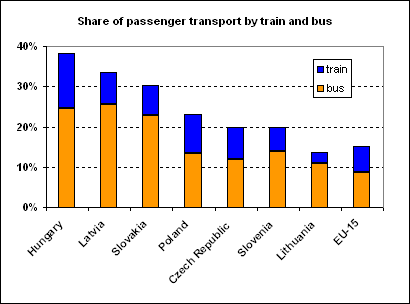
A number of studies have debunked the widespread myth that motorways drive economic development. Economic impacts are as often positive as negative, depending on specific circumstances. Moreover, this does not include the negative external costs of transport, such as accidents, damage to health, and climate change impacts, which are estimated at around 8% of the EU's GDP. If any transport investments are vital for the everyday life of most people and for regional development, it is support for public transport, the rehabilitation of local and regional railways and roads, and improvements in transport safety.
In the cities of Central and Eastern Europe, funding for public transport was cut back in the 1990s. In Budapest, municipal subsidies to the public transport company were reduced by two thirds between 1990 and 2000. The result has been higher fares and a lack of funds for the renewal of vehicles, encouraging a switch to private car use. The number of cars per person is already higher in the Czech Republic and Slovenia than in one of Europe’s richest countries, Denmark. This trend needs to be reversed through the focused investment of EU funds into metro and tram systems, as well as bicycle lanes and the creation of pedestrian zones.
More on transport and EU fundsEnergy: boosting efficiency and renewables
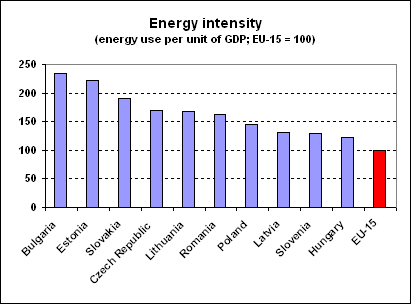
It takes on average 50% more energy to produce a unit of GDP in the CEE region as it does in Western Europe (see chart). The potential for energy savings in the region is thus huge, especially when high energy expenditure in CEE states undermines their competitiveness. EU funds could help secure massive energy savings across the economy and thus reduce energy bills for households, schools, hospitals, municipalities (e.g. by switching to efficient public lighting) and businesses.

In particular, EU funds should be invested into the insulation of buildings and the modernisation of district heating installations. District heating is commonplace in the new member states, with around 40% of households connected in comparison with 10% in the old member states. Old coal or oil boilers can be converted to modern, efficient gas or biomass boilers. Many district heating installations can also be redesigned for the combined generation of heat and electricity.
EU funds should also be used to unlock the large but unused renewable energy potential of CEE countries. Not only are biomass, wind and solar energy clean, but they also generate net benefits for the economy. In Germany, for example, 150,000 people are employed in the renewable energy sector today, three times more than in the entire coal sector. Experience also shows that the renewable sector is based on small and medium enterprises and thus is more decentralised. While nuclear and coal power plants or mines concentrate employment in only a few big centres, which become dependent on them, renewables spread jobs and other benefits more evenly across many communities and regions.
Waste: goodbye to the throw-away society?
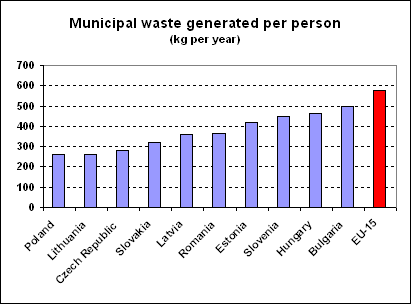
The amount of municipal waste coming mainly from households is still significantly lower in CEE countries than in the old EU-15 (see chart). Poland, the Czech Republic and Lithuania each produce less than half the EU-15 average. The danger is that waste amounts will increase drastically in line with increased material consumption.

Most recyclable household waste is landfilled and burned causing significant pollution. Moreover, this is an outright waste of precious natural resources. Every ton of wasted material which ends up in a landfill or an incinerator must be extracted or produced again, leading to further pollution, energy use and expensive imports.
Recycling, reuse, and composting of waste are not only more environmentally sound than incineration and landfilling, but also create significantly more jobs for the same amount of money. With a focused investment of EU funds on these methods, the new member states will be able to make the switch from a throw-away society into a resource efficient economy within a decade.
However, there is a danger that the pressure to absorb all the EU money for the 2007-2013 period will lead to the construction of oversized incineration and landfill capacities which will in turn encourage increases in waste production. Dozens of new incinerators (often called “energy recovery plants”) are planned to be built in the CEE region with the help of EU funds. This would perpetuate the unsustainable approach to the waste problem for many years to come.
More on waste and EU fundsNature protection: an economic asset

EU funds can and should be used to support protected areas in the European "Natura 2000" network and river basin management under the Water Framework Directive. The protection of nature is not only crucial to halting the loss of biodiversity and to ensuring the long-term sustainability of economic development, it is also an economic asset. National parks and nature reserves attract eco-tourism and create jobs in marginal regions. The new member states brought an invaluable gift to the EU in this regard: large areas of wild or well-preserved nature, beautiful landscapes and many species that are already extinct in the EU-15. As for the river basins, the protection of floodplain forests and meadows reduces the damaging power of floods which have repeatedly hit the CEE region in recent years.

However, EU funds could well undermine the EU's own nature and river protection policies. Many of the natural treasures of CEE countries including the Biebrza and Narew parks in Poland, Kresna gorge in Bulgaria, as well as the intact stretches of the Danube, Tisza, Wisla and Morava river basins, may soon be sacrificed to make way for reckless construction projects subsidised by EU funds. There are also dozens of potential clashes between the EU's trans-European transport network – including many new big road projects – and the Natura 2000 network.
Fortunately, most of the conflicts between economic development and nature protection can be prevented through better planning, consultations, and properly carried out SEA and EIA procedures. Yet question marks remain as to whether there is the political will to do so at both the national and EU levels.
Mixed record of EU funds: experience from the old member states
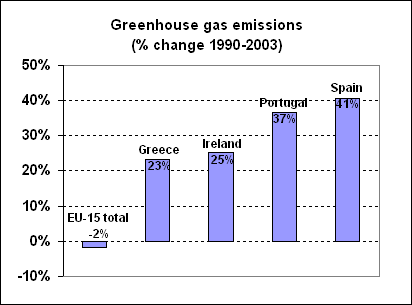

In Greece and southern Italy, for many years a lot of EU aid was wasted on projects of little value amid reports of widespread corruption. In contrast, countries like Ireland gradually learned to make more effective use of its EU money through well-coordinated strategic targeting of funds. Ireland also invested much more, including national funds, into research, training and innovation than into transport infrastructure.
The environmental record of EU funds is also mixed. A lot of money has been invested into so-called environmental infrastructure in the poorer EU countries, such as water treatment plants, sewage systems, and waste disposal facilities. However, very little was done in terms of tackling pollution at the source.
The record of EU funds on climate change – one of the biggest challenges for mankind – has up to now been an unequivocal failure. The four "cohesion countries" (Greece, Ireland, Portugal and Spain), which have so far received the most EU money, have also witnessed by far the greatest increases in greenhouse gas emissions in the EU (see chart). While the blame cannot be wholly pinned on EU funds, EU money has undoubtedly helped to fuel climate change instead of cooling it.
Rocketing fuel prices require a shift to efficiency
World fuel prices have recently soared to record levels and are set to remain high. At the same time, the effects of climate change are being increasingly felt through more frequent and extreme droughts and floods. Business as usual cannot be an option. CEE countries must not repeat the development mistakes of western Europe.
EU funds in the new member states need to be directed towards energy and resource efficiency, renewable energy, eco-friendly technologies and sustainable transport. This kind of development will reduce oil dependence as well as climate pollution, and will support competitiveness, technological innovation and job creation.
GDP is not the way to measure development
The growth of GDP (gross domestic product) does not automatically make any society modern and healthy. GDP does not account for the negative social and environmental costs of growth and often treats them as benefits, even when they decrease the well-being of people, e.g. the clean-up of pollution and ecological disasters, paying for noise barriers, medical costs due to pollution, and car wrecks. Growth should therefore be conditioned by measurable social and environmental progress and by a real reduction of regional disparities in living standards. However, the EU’s cohesion policy is still based on the standard narrow and misleading GDP indicator, while even China has already introduced the concept of “green GDP” – taking negative environmental impacts into account when measuring development in its provinces.
EU funds and corruption
Studies show that the construction sector is more prone to corruption than any other economic sector. As this is the sector which benefits most from EU funds, governments and the EU must emphatically insist on the proper use of the money, which means that the spending must be transparent and it must involve public participation. In this way EU funds could actually help reduce overall corruption in CEE by spreading good practice throughout the public administration sectors.
Making effective and environmentally sustainable use of EU funds

- Strategic vision at all levels: The lesson from the old member states (e.g. Wales or Ireland) is that local, regional and national authorities need to develop and stick to clear strategies rather than just spread money around on various projects with short-term impacts and few public benefits.
- Facilitate access to EU funds for small applicants: National or regional administrations should use a small part of the funds to establish professional and free-of-charge public services that assist municipalities, citizen groups and small businesses with the preparation of high quality projects, while taking care of the bureaucratic burden. Such a scheme functions productively in Wales for example.
- Environmental assessments: Negative environmental impacts of EU funded programmes and projects can be prevented through Strategic Environmental Assessments (SEA) and Environmental Impact Assessments (EIA). These obligatory procedures, which involve consultations with the public, enable the programmes and projects to be optimised and any environmental damage to be minimised. However, if such assessments are only treated as rubber-stamping exercises, EU funding should be strictly rejected.
- Environmental and social selection criteria: Selection criteria for EU funding should attribute more points to projects with positive environmental and social impacts, while projects with negative impacts should be disqualified. Such a system has been implemented in Austria for example.
- Involvement of civil society: Municipal self-governments, non-governmental organisations, trade unions and the academic sector should be given a greater say in the monitoring of EU funds in order to offset the disproportionate influence of various lobbies and to prevent misuse and corruption.